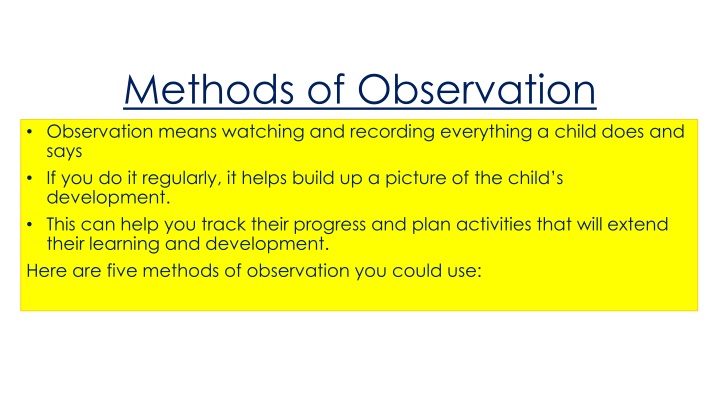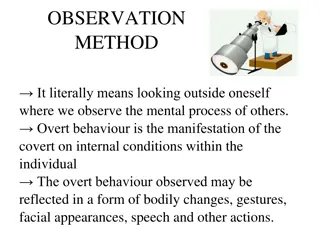Effective Child Development Observation Methods
Observing children is a crucial aspect of tracking their development. Naturalistic Observation, Event Sampling, Snapshot Observation, and Non-Participative Observation are effective methods outlined in the content. These methods help in capturing a child's behavior, interactions, and progress, aiding in planning appropriate activities for their learning and growth.
Download Presentation

Please find below an Image/Link to download the presentation.
The content on the website is provided AS IS for your information and personal use only. It may not be sold, licensed, or shared on other websites without obtaining consent from the author.If you encounter any issues during the download, it is possible that the publisher has removed the file from their server.
You are allowed to download the files provided on this website for personal or commercial use, subject to the condition that they are used lawfully. All files are the property of their respective owners.
The content on the website is provided AS IS for your information and personal use only. It may not be sold, licensed, or shared on other websites without obtaining consent from the author.
E N D
Presentation Transcript
Methods of Observation Observation means watching and recording everything a child does and says If you do it regularly, it helps build up a picture of the child s development. This can help you track their progress and plan activities that will extend their learning and development. Here are five methods of observation you could use:
Naturalistic Observation (also sometimes called a Narrative Observation) You observe a child s natural, spontaneous (unplanned) behaviour for a set period of time, say 5 minutes. This method is good for when a child is doing child-led play when they might change activities and move around the room. The observer also records how other children and adults interact with the child, including their speech The observer watches them and writes down everything they see and hear the child say, including any gestures and facial expressions Because this is difficult to do, the observer only does it for a short length of time less than five minutes. Naturalistic Observation Child s name: Observer: Date: Time: Duration: Location: What happened:
Event Sampling You would normally use this if you wanted to see how often a particular aspect of a child s behaviour or development occurs (i.e. when the child interacts socially with another child, or when they talk to themselves during imaginative play) You can do it throughout a single play session, or over a whole day or a whole week. You need to prepare a form in advance every time the behaviour you are looking for occurs, you write in a record of the time and circumstances Event No: Time it happened What was the event? What were the circumstances (in detail) 1 2 3 4 5 6
Snapshot Observation This type of observation happens when you notice a child doing something of interest and spontaneously observe them very briefly, just for a minute or two The child may be showing a new skillthat you haven t seen them do before, or may be playing in a particular way that you have been hoping to see. Sometimes these very short observations are recorded on Post It notes, because this makes it quick and efficient. The idea of these short observations is that they build over time to provide a picture of the child s development. Date What the child did (in detail) What this showed me
Non Participative Observation This is when you, the observer watches the child doing an activity without the child realising you are observing them. You mustn t talk to the child or interact with them in any way. This will give you a really good chance to observe the child s natural behaviour. Don t write down your speech or actions, only the ones done by the child. The observations can be done for short periods of time less than five minutes. You could use the narrative observation method to write down what the child says and does. Narrative Observation Child s name: Observer: Date: Time: Duration: Location: What happened:
Participative Observation This happens when you, the observer, deliberately interacts with the child during the observation. You might ask the child to do certain things to see if they meet particular milestone tasks. ( you will have to be clear about what milestones they should meet at their particular age/stage of development) You could ask a child questions to check their understanding of something. (e.g. what happened then? or why did you do that? ) Any information you find out has to be recorded on a checklist form. Activity/ Norm of Development Date child is able to do this Photographic evidence? Date child attempts to do this Date child does not attempt to do it Comments on child s activity
Writing up observation Do: Produce a piece of writing which discusses what the child demonstrated at your visit for each of the PIES. Say what the child should be able to do and link it to what you saw by saying, I saw this when . Use the photographs as evidence of what you saw and explain what they show. Don t: Just write a story about what happened without linking it to the expected development. Just put pictures in without saying what they show. Only comment on one element of PIES development. Choose your presentation style: EITHER Use the chart on slide 6 as you did a participative observation OR Write this as a report, including what you saw and using the tips above.























